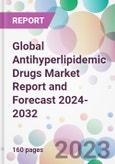The global antihyperlipidemic drugs market was valued USD 12.9 billion in 2023 driven by the increasing prevalence of cardiovascular diseases, rising awareness of lipid management, and the aging population has led to market growth across the globe. The market size is anticipated to grow at a CAGR of 5.8% during the forecast period of 2024-2032 to achieve a value of USD 21.4 billion by 2032.
North America and Europe are prominent markets for antihyperlipidemic drugs due to their well-established healthcare infrastructure and high prevalence of cardiovascular diseases. Emerging markets in Asia Pacific, Latin America, and Africa are experiencing growth in demand as awareness of cardiovascular health increases. global antihyperlipidemic drugs market is significant and continues to expand due to the increasing burden of cardiovascular diseases worldwide. These medications are a cornerstone of lipid management and are used in various clinical settings to reduce cardiovascular risk and improve patient outcomes. The market is characterized by a range of drug classes and is influenced by factors such as advances in pharmaceutical research and changing demographics.
Antihyperlipidemic Drugs: Introduction
Antihyperlipidemic drugs, also known as lipid-lowering medications, are a class of pharmaceuticals used to manage and control elevated levels of lipids (fats) in the blood. These drugs are primarily used to treat conditions like hyper lipidaemia, which is characterized by abnormally high levels of cholesterol and triglycerides in the bloodstream. Elevated lipid levels can increase the risk of cardiovascular diseases, including heart attacks and strokes. Antihyperlipidemic drugs play a crucial role in preventing and managing cardiovascular diseases, which are among the leading causes of death worldwide. They help lower elevated lipid levels, reduce the risk of atherosclerosis (hardening and narrowing of the arteries), and improve overall cardiovascular health.Key Trends in the Global Antihyperlipidemic Drugs Market
- Rising Awareness of Lipid Management: Greater awareness of the importance of lipid management and the consequences of elevated cholesterol levels is leading to more individuals seeking medical treatment. Healthcare providers are increasingly emphasizing cholesterol control.
- Expanding Aging Population: As the global population ages, the prevalence of cardiovascular risk factors, including hyperlipidemia, tends to increase. This demographic trend is contributing to sustained demand for antihyperlipidemic drugs.
- Shift Toward Combination Therapies: To achieve optimal lipid control, healthcare providers are increasingly prescribing combination therapies that include multiple classes of antihyperlipidemic drugs. This approach targets different aspects of lipid metabolism and offers more comprehensive treatment.
- Emerging Therapies: The development of novel lipid-lowering therapies, such as proprotein convertase subtilisin/kexin type 9 (PCSK9) inhibitors, has provided additional options for individuals who do not adequately respond to traditional medications like statins.
Global Antihyperlipidemic Drugs Market Segmentation
The market can be categorised drug class, distribution channel, end user and region.Market Breakup by Drug Class
- Statins
- PCSK9 Inhibitors
- Bile Acid Sequestrants
- Cholesterol Absorption Inhibitors
- Fibric Acid Derivatives
- Combination
Market Breakup Disease by Distribution Channel
- Hospitals Pharmacies
- Retail Pharmacies
- Drug Stores
- E-Commerce
Market Breakup by Region
- North America
- Europe
- Asia Pacific
- Latin America
- Middle East and Africa
Global Antihyperlipidemic Drugs Market Overview
The global antihyperlipidemic drugs market is a significant segment within the pharmaceutical industry, driven by the increasing prevalence of cardiovascular diseases, rising awareness of lipid management, and the aging population. Antihyperlipidemic drugs play a vital role in managing and reducing the risk of heart-related conditions associated with elevated lipid levels. The global antihyperlipidemic drugs market is substantial and continues to grow. The prevalence of cardiovascular diseases and the need for lipid-lowering medications contribute to its expansion. The market's growth is influenced by various factors, including demographic trends, lifestyle changes, and advances in pharmaceutical research and development.North America and Europe are prominent markets for antihyperlipidemic drugs due to their well-established healthcare infrastructure and high prevalence of cardiovascular diseases. Emerging markets in Asia Pacific, Latin America, and Africa are experiencing growth in demand as awareness of cardiovascular health increases. global antihyperlipidemic drugs market is significant and continues to expand due to the increasing burden of cardiovascular diseases worldwide. These medications are a cornerstone of lipid management and are used in various clinical settings to reduce cardiovascular risk and improve patient outcomes. The market is characterized by a range of drug classes and is influenced by factors such as advances in pharmaceutical research and changing demographics.
Key Players in the Global Antihyperlipidemic Drugs Market
The key features of the market report include patent analysis, grants analysis, clinical trials analysis, funding and investment analysis, partnerships, and collaborations analysis by the leading key players.The major companies in global antihyperlipidemic drugs market are as follows:
- Bristol-Myers Squibb Company
- Merck & Co.
- AstraZeneca
- Mylan N.V
- Abbott
- Aparito Ltd.
- Amgen Inc.
- Daiichi Sankyo Company
- Pfizer Inc.
- Dr. Reddy’s Laboratories Ltd
Table of Contents
1 Preface
3 Global Antihyperlipidemic Drugs Market Overview
4 Global Antihyperlipidemic Drugs Market Landscape
5 Global Antihyperlipidemic Drugs Market Dynamics
6 Global Antihyperlipidemic Drugs Market Segmentation
7 North America Global Antihyperlipidemic Drugs Market
8 Europe Global Antihyperlipidemic Drugs Market
9 Asia Pacific Global Antihyperlipidemic Drugs Market
10 Latin America Global Antihyperlipidemic Drugs Market
11 Middle East and Africa Global Antihyperlipidemic Drugs Market
12 Regulatory Framework
13 Patent Analysis
14 Grants Analysis
15 Clinical Trials Analysis
16 Funding and Investment Analysis
17 Partnership and Collaborations Analysis
18 Supplier Landscape
20 Company Competitiveness Analysis (Additional Insight)
21 Payment Methods (Additional Insight)
Companies Mentioned
- Bristol-Myers Squibb Company
- Merck & Co.
- AstraZeneca Mylan N.V Abbott
- Aparito Ltd.
- Amgen Inc.
- Daiichi Sankyo Company
- Pfizer Inc.
- Dr. Reddy’s Laboratories Ltd
Methodology

LOADING...








